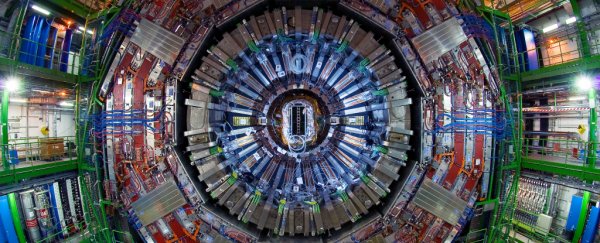Recent results from the Large Hadron Collider (LHC) in Switzerland hint at activity going on beyond the standard model of particle physics - which means we could finally be about to enter a new era in physics.
Right now, the standard model is the best explanation we have for how the Universe works and how it's held together. But there are big gaps - most noticeably, the fact that the model doesn't actually account for gravity - so scientists have spent decades probing the boundaries of physics for signs of any activity that the standard model can't explain. And now they've found one.
The discrepancy deals with a particle called the B meson. According to the standard model, B mesons should decay at very specific angles and frequencies - but those predictions don't match up what's been seen in LHC experiments, suggesting that something else is going on. And if we can figure out what that is, it'll take us closer to unlocking some of the mysteries in our Universe.
"Up to now all measurements match the predictions of the standard model," said lead researcher Mariusz Witek, from the Institute of Nuclear Physics of the Polish Academy of Sciences. "However, we know that the standard model cannot explain all the features of the Universe. It doesn't predict the masses of particles or tell us why fermions are organised in three families. How did the dominance of matter over antimatter in the universe come about? What is dark matter? Those questions remain unanswered."
The data in question was collected in 2011 and 2012, and was first spotted last year, when scientists noticed that the rate of B meson decay didn't match up with standard model predictions.
But now the team of Polish researchers has shown that it's not just the rate of decay, but also the angle of decay that's at odds with the standard model.
"To put it in terms of the cinema, where we once only had a few leaked scenes from a much-anticipated blockbuster, the LHC [Large Hadron Collider] has finally treated fans to the first real trailer," said Witek.
According to the standard model, B mesons are made up of a light quark and a heavy beauty antiquark - and because of that quark-antiquark pairing, they decay rapidly, and should shoot their products off at specific angles.
While physicists had already noticed something odd about the timing of that decay, they weren't able to pick up the discrepancy in the decay angle, because their method of measuring it wasn't accurate enough.
But thanks to a new technique developed by the Polish physicists, they were able to show that not only did B mesons in 2011 decay at an angle that wasn't predicted by the standard model, the same thing also happened in 2012.
The researchers are very clear that we can't yet call this a discovery - we need more data before we can say for sure whether what's been found is actually real. The team has currently reached a standard deviation of 3.4 sigma, which is pretty good, but to talk about a new discovery, they need to get above 5 sigma - which would mean there's less than a one in 3.5 million chance that the discovery is a fluke.
So what does it mean if B mesons decay at different angles than the Standard Model predicts? It could suggest the activity of a brand new particle, and the most popular hypothesis at the moment is that a new intermediate Z-prime boson - not predicted by the standard model - is influencing the decay of these B mesons.
The good news is that the LHC has recently started smashing protons together at higher energy levels than ever before, and the physicists will soon have a whole new batch of data to analyse. And that data could hold the key to taking physics to the next level.
"Just like it is with a good movie: everybody wonders what's going to happen in the end, and nobody wants to wait for it," says Witek.
Watch this space.
The results have been published in the Journal of High Energy Physics.
